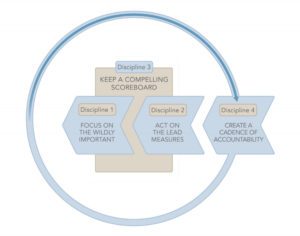 This is another post comparing my views on Strategy Deployment and other approaches. This time the Four Disciplines of Execution (or 4DX), described in the book of the same name.
This is another post comparing my views on Strategy Deployment and other approaches. This time the Four Disciplines of Execution (or 4DX), described in the book of the same name.
I’d heard about 4DX from a few people over the last years; notably Hakan Forss and Matt Wynne. I finally got around to reading the book, found it immediately useful, and started incorporating the ideas into my work with a few organisations.
This is how I see the four disciplines relating to Strategy Deployment and TASTE.
Discipline 1: Focus on the Wildly Important
This is the discipline of Focus, asking “if every other area of our operation remained at its current level of performance, what is the one area where change would have the greatest impact?”. This focus is defined as a Wildly Important Goal (WIG) in the form of a statement “From X to Y by When” which describes the current situation the future ambition and a timescale. This WIG should be both “worthy” and “winnable” and the formula can be used as the Aspiration in TASTE.
Note: While 4DX encourages a single WIG I’d caution against focussing too strongly on one measure at the expense of other measures. The example of Lance Armstrong having the Tour de France as his WIG hasn’t stood the test of time very well!
Discipline 2: Act on Lead Measures
This is the discipline of Leverage, with a lead measure being defined as one where “it’s predictive of achieving the goal and it can be influenced by the team.” Again, its worth considering when the lead measure might also lead to negative consequences and pay attention to those as well. Lead Measure are a form of Evidence in TASTE
Discipline 3. Keep a Compelling Scorecard
This is the discipline of Engagement, and as such the compelling scoreboard “tells the team where they are and where they should be, information essential to team problem solving and decision making.” Thus the compelling scoreboard is a visualisation of both the Aspirations and Evidence in TASTE.
Discipline 4. Create a Cadence of Accountability
This is the discipline of Accountability, and provides a forum for each team member to answer the question “What are the one or two most important things I can do this week to impact the team’s performance on the scoreboard?” as well as reporting back on achievements from the previous week. Thus this regular cadence, either daily or weekly, provides the mechanism for a Catchball process, where people can collaborate on discovering and evolving their own solutions to move the Lead Measures (Evidence) to achieve the WIG (Aspirations). The Cadence of Accountability is how work is progressed as the Tactics in TASTE.
As you can see, 4DX can be mapped directly on TASTE, with the only major missing piece being the Strategies. This conclusion is very similar to one I described when I wrote about Strategy Deployment and OKRs. However, as with OKRs, I’d recommend 4DX as a relatively quick (although not necessarily easy) way of getting started with Strategy Deployment.

[…] Source AvailAgility […]